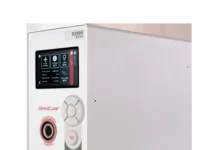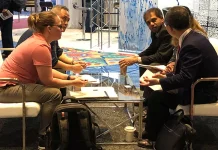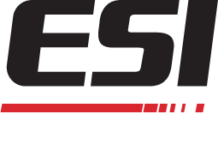Submitted by RadTech Europe
 If proof were needed, last year’s RadTech Europe Conference at the Clarion Congress Hotel in Prague (CZ) certainly proved how dynamic and diversified the world of radiation curing is today. Held October 13-15, 2015, the conference was headlined UV/EB Now – new place, new format and new applications.
If proof were needed, last year’s RadTech Europe Conference at the Clarion Congress Hotel in Prague (CZ) certainly proved how dynamic and diversified the world of radiation curing is today. Held October 13-15, 2015, the conference was headlined UV/EB Now – new place, new format and new applications.
For the benefit of some 440 delegates, 60 speakers addressed the plethora of chemistries, technologies and applications that today employ UV and EB curing in an intense and wide-ranging program. The formal agenda was partnered with a parallel exhibition featuring leading technology providers and incorporating a small theater where exhibitors could introduce their latest products.
Conference keynote
Conference chairman Dawn Skinner of Heraeus Noblelight America LLC (UK) opened the plenary conference session. It featured a challenging, thought-provoking keynote from Lars Sonderegger of behavioral management specialists Quantonomics (CH) on the key topic of the most effective routes to innovation and value creation.
He showed how our current digitally enabled era has only added complexity to our decision making, leaving us with less time to actually define appropriate solutions to life challenges. He advocated developing a strategy, based on behavioral science, on how individuals, their teams and everybody in the company interacts. “The human brain is a social brain, with biological wiring which works better when it collaborates with other people,” he explained. We need to get connected in person, as well as digitally, because the chemistry of person-to-person contact is different from that involved in making contact via mobile phones or videoconferencing. Facial expressions, posture, talking, listening and simply being together all combine to create an environment that is the basis for learning, sharing, defining real needs and wants and, of course, ultimately mapping the path to innovation. “The higher the alignment is, the higher will be the innovation and therefore success rate!” he emphasized.
US market overview
 In a review of innovations and developments in the US market, Gary Cohen of RadTech International North America (US) explored the many innovations in the radiation-curing market, which are creating the expectation of a compound annual growth rate for the industry of more than twice US GDP for the next three years, and a growth rate of more than 7 percent over the next two years for the current up-and-coming applications – 3D printing, inkjet and fingernail decoration.
In a review of innovations and developments in the US market, Gary Cohen of RadTech International North America (US) explored the many innovations in the radiation-curing market, which are creating the expectation of a compound annual growth rate for the industry of more than twice US GDP for the next three years, and a growth rate of more than 7 percent over the next two years for the current up-and-coming applications – 3D printing, inkjet and fingernail decoration.
European market overview
The world total for radiation-cured finished products today is an estimated 520,000 metric tons, RadTech Europes President, David Helsby, RAHN AG (CH), said, as he began his evaluation of European market developments. He confirmed that the DACH region still is Europes largest consumer of UV/EB technologies, representing 42 percent of the market. Identifying major trends, he examined the raft of regulatory compliance requirements, observing that those of the end-user companies – e.g. Nestlé, TetraPak and IKEA – are in fact stronger than the formal EU legislation. What, he wondered, “will come next in the way of requirements and regulations?” and how will the unpredictable issues – crude oil prices, raw material costs, freight, interest rates and currency – affect the industry?
Parallel programs
An impressive succession of parallel programs then split the delegate base into different streams for the remainder of the three days, covering advances in photochemistry and polymerization; developments in printing technology; HSE and the safe use of UV/EB; advances in UV-LED technology; 3D printing; innovations in applications; developments in coatings and formulations; innovations in chemistry and materials; and advances in UV/EB equipment and process control.
“The depth and diversity of the subjects addressed by the expert speaker base are testimony to an industry that is a real center for innovation and growth,” said Helsby. “The more technical face of the conference has unquestionably created huge interest – as the considerable growth in the delegate base, spanning industry and academe confirms.”
Legislative matters
Legislation – particularly REACH – figures strongly in the radiation curing industry’s agenda today. Dr. Didier Vanhoye of Sartomer (FR) – a corporate member of the REACH Polymerisable Acrylate Resins and Derivatives Consortium – provided an update on tier 1 and 2 registrations of (meth)acrylic monomers, their evaluation, the main remaining issues prior to tier 3 registration and potential industry impacts. Legislation around hazardous goods transportation, packaging materials for food contact and UV inks for food packaging, mercury exemption status under RoHS and Bisphenol-A also were discussed in a session chaired by Andy Boon of Sun Chemical (UK).
Photochemistry and photopolymerization
The key areas of photochemistry and photopolymerization brought together a number of specialist papers from European experts. Joint chairmen Xavier Allonas, Université de Haute Alsace (FR), and Prof. Marco Sangermano, Politecnicio di Torino (IT), introduced in-depth studies of aspects of photoinitiators, photopolymerization and the use of CTAs.
Developments in printing technology
Printing technology has been a key development arena for UV curing in recent years and, in the dedicated conference session chaired by Nick Ivory, Sun Chemical (UK), Sandra Schlögl’s award-winning paper on UV-induced ink foaming for the formation of 3D structures in offset printing was joined by explorations of EB-curable CI-flexo ink for sustainable packaging print; water-based UV inkjet; controlling the variables in UV LED curing in low-migration printing; UV LED curing formulations for inks and coatings; and the state of the art in UV inkjet print on food packaging.
UV-LED
UV-LED technology was the focus of the session chaired by Paul Kelly of Perstorp (UK), which attracted extremely high attendance – evidence of the considerable activity and interest in this particular field. Content spanned new resin and formulation developments; improved surface cure with deep-UVC LEDs; the impact on UV-curing applications of advances in UV-LED technology; developments in UV-LED equipment; and solutions to enhance the performance of UV-LED and low-energy-curable systems.
3D printing
The session on 3D printing/additive manufacturing, chaired by Susanne Piontek, BASF Coatings (DE), opened with an overview of the history and status quo from the 3D Printing Association Membership Director Ian Ferguson (UK). He asked: “Will every home have a consumer 3D printer within the next ten years?” He answered, “Some say yes!” However, growth drivers in mainstream industry now are clear to see, including on-demand manufacturing and speed to market, from idea to product. Some challenges remain, particularly in achievable printing speeds and materials diversity. The conference session went on to record developments in different aspects of 3D UV inkjet printing and exciting advances in photopolymerization for human tissue engineering.
Innovation in applications
 The field of medicine featured again in the session covering innovation in applications, chaired by Massimo Cattaneo of IGT Resins (IT). Photopolymerized adhesives for wound seals in biological tissues were the opening topic, and the session also covered a review of globally competitive Russian radiation technologies, photo-cured encapsulant for photovoltaic panels and smart “photoswitchable” self-healing composite materials. Proving that radiation curing is not just a topic for todays technologies, the session closed with a paper on preserving 19th-century documents on paper by stabilizing the acid pH of the wood pulp.
The field of medicine featured again in the session covering innovation in applications, chaired by Massimo Cattaneo of IGT Resins (IT). Photopolymerized adhesives for wound seals in biological tissues were the opening topic, and the session also covered a review of globally competitive Russian radiation technologies, photo-cured encapsulant for photovoltaic panels and smart “photoswitchable” self-healing composite materials. Proving that radiation curing is not just a topic for todays technologies, the session closed with a paper on preserving 19th-century documents on paper by stabilizing the acid pH of the wood pulp.
Chemistry and materials innovation
Innovation in chemistry and materials are at the very heart of the radiation curing industry, and a dedicated session, chaired by Stephan Peeters of Allnex (BE), documented several routes to future success. Papers covered the production of thermoset fibers using UV curing; a UV-activated hydrosilation reaction for silicone polymer cross-linking; UV switchable crosslinks in rubber materials; dual-cure polymerization of acrylates – successfully applied in the fabrication of carbon fiber composites using LED irradiation; renewable itaconic acid-derived binder vehicles used in radical UV/EB curing; and electron beam-induced graft copolymerization.
Coatings and specialist formulations
 Coatings and specialist formulations also is an area of particular current interest, and Christophe Vergé of Sartomer (FR) chaired a session that highlighted recent developments. Soft-touch coatings that are 100 percent UV-curable; self-replenishing hydrophobic coatings; a new photoacid generator for cationic polymerization of, e.g., epoxides; a novel IR and UV hybrid irradiation process for photon delivery; and the outlook for UV/EBs role in automotive coatings were all discussed.
Coatings and specialist formulations also is an area of particular current interest, and Christophe Vergé of Sartomer (FR) chaired a session that highlighted recent developments. Soft-touch coatings that are 100 percent UV-curable; self-replenishing hydrophobic coatings; a new photoacid generator for cationic polymerization of, e.g., epoxides; a novel IR and UV hybrid irradiation process for photon delivery; and the outlook for UV/EBs role in automotive coatings were all discussed.
UV/EB equipment and process control
Finally, it is, of course, the combination of equipment and process controls that deliver a successful final result. The closing conference session, chaired by Dawn Skinner (UK), looked at some of the key advances, including the use of integrating sphere technology for uniform UV curing, achieving precise UV-LED measurements, future directions for EB systems, low-dose EB irradiation using particle-based dosimetry, homogeneous seed treatment using a toroidal electron source, and Russian contributions in the development and use of industrial accelerator technologies.
Event sponsors
Europe’s 2015 event for UV/EB curing was sponsored by many leading companies, including gold sponsors Allnex, Arkema, BASF, BYK, DSM Coating Resins, Dymax, Heraeus Noblelight, IGM Resins, Lambson and Rahn, and silver sponsors Nedap Light Controls, Opsytec Dr. Groebel, PCT Engineered Systems and Siltech.






